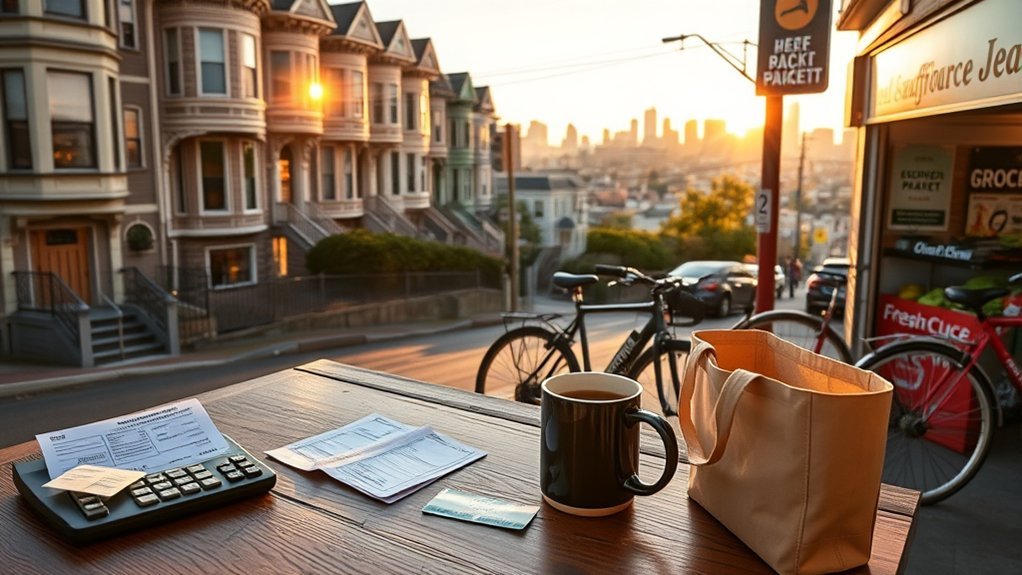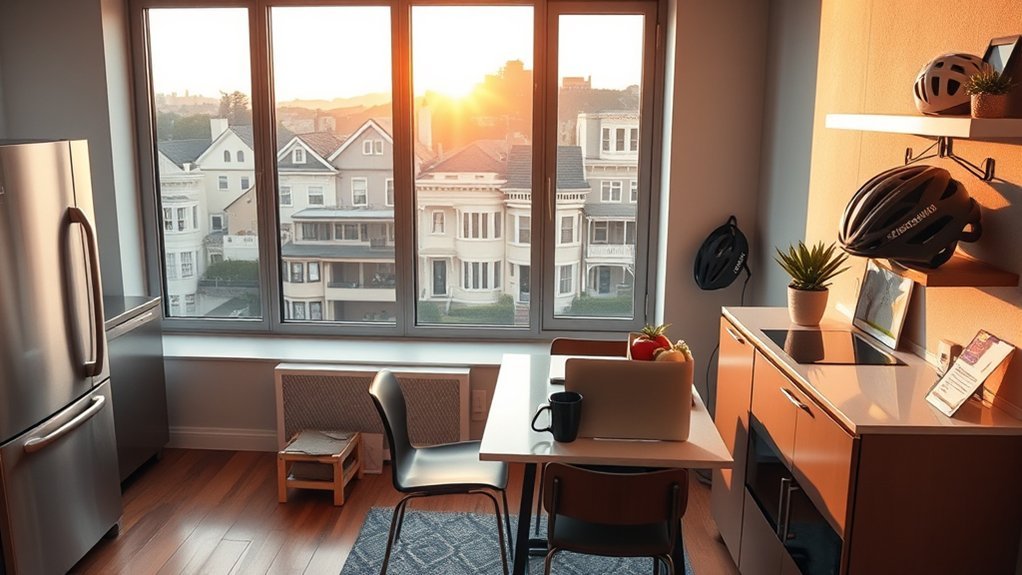You can enjoy world-class food and culture while your rent eats half your paycheck. If you live in San Francisco, expect a median one-bedroom rent around $3,019 and monthly costs for a single person near $4,676 — housing dominates but groceries, utilities, transport, healthcare, and childcare add up fast. I’ll break down where the money goes, what typical budgets look like, and practical ways to stretch your dollars so you can plan realistically.
Cost of Living Overview for San Francisco Residents

Because San Francisco’s prices are well above the national norm, you’ll want to budget carefully: a single person spends about $4,676 per month on average, while a family of four typically spends around $11,345.
You should view the San Francisco cost of living as concentrated: housing costs and essential expenses drive most of your monthly budget. With median rent for one- and two-bedroom units high, average monthly rent markedly inflates overall living expenses and pushes many households to allocate more than half their income to shelter.
San Francisco’s cost of living is concentrated: steep housing and essentials often force households to spend over half their income on shelter.
Grocery costs run about 24% above the national average, so plan $1,200–$1,500 monthly for a family of four. Compare that against median household income to test affordability and adjust choices like neighborhood or household size.
Track fixed costs (rent in San Francisco, utilities, insurance) and variable spending (food, transport) to build a realistic monthly budget that covers essential expenses without surprise shortfalls.
Average Rent and Housing Expenses by Apartment Size

You’ll find one-bedroom rents average about $3,019 and two-bedrooms around $3,579 in San Francisco, with one-bedrooms up nearly 11% year over year.
To afford those rents comfortably, you’d need roughly $120,760 annually for a one-bedroom and $143,160 for a two-bedroom.
Buying is far costlier — median home prices exceed $1.2 million — so you’ll want to compare long-term equity gains against higher upfront costs and monthly housing payments.
One‑Bedroom Costs
Renting a one‑bedroom in San Francisco will cost you roughly $3,019 on average, with city‑center units around $3,107 and neighborhoods outside the core averaging $2,684.
You should factor that average rent into your monthly budget and overall housing expenses: rental prices rose nearly 11% in the last year due to high demand and low vacancy.
To comfortably afford a one‑bedroom, you’d need about $120,760 in annual income, reflecting how the city’s cost of living compares to its median home price, which tops $1.2 million.
Practically, expect tight availability, higher utility and insurance costs, and a need to prioritize location versus square footage when planning your housing portion of the budget.
Two‑Bedroom Costs
One common two‑bedroom in San Francisco now runs about $3,579 per month on average, a noticeable jump from last year that pushes the income needed to afford it to roughly $143,160 annually. You’ll find the average rent for a two‑bedroom apartment varies by location, with outside‑center listings averaging $4,520. Housing costs here are about 163% above the national average, so expect higher monthly expenses and strong financial demand compared with other markets. Add utilities and essentials (~$226.86/month) to get a realistic budget. Below is a simple snapshot to visualize typical costs:
| Item | Typical monthly figure |
|---|---|
| Two‑bedroom average rent | $3,579 |
| Outside‑center rent | $4,520 |
| Utilities | $227 |
| Required annual income | $143,160 |
Buying vs. Renting
Having looked at typical two‑bedroom costs, let’s compare what you’ll pay to rent by apartment size versus what buying will demand.
The Average Rent in San for a one‑bedroom is about $3,019 and two‑bedrooms average $3,579; three‑bedrooms run roughly $5,667 downtown or $4,520 outside.
That Rent level makes monthly rent in San a significant expense within your monthly budget and implies a suggested annual income near $120,760 just to afford a one‑bedroom comfortably.
By contrast, the median home tops $1.2 million, so purchasing property brings much larger upfront costs, mortgage, taxes and maintenance.
With vacancy at ~3.1%, housing prices stay high.
When weighing buying vs. renting, factor liquidity, long‑term equity goals, and ongoing financial demands.
Monthly Budget Breakdown: Groceries, Utilities, and Transportation

When you map out a monthly budget in San Francisco, groceries, utilities, and transportation will often take up a predictable share of your expenses.
Expect groceries to average $400–$600 for a single person and $1,200–$1,500 for a family of four. Basic utilities for an 85m² apartment run about $255 monthly, covering electricity, heating, cooling, water, and garbage.
Add connectivity: a mobile plan with 10GB+ data is roughly $54 and internet (60+ Mbps) averages $64.
Transportation can be a larger line item: a monthly Muni pass is about $81, while average annual transportation expenses reach roughly $10,323, so factor commuting, rideshares, and occasional car costs into your monthly budget.
Use these averages to build scenarios — lean single-person, mid-range family, or transit-heavy commuter — and adjust for dietary preferences, energy use, and remote-work reductions in commuting to keep your plan realistic and actionable.
Healthcare, Child Care, and Education Costs

Although healthcare and schooling mightn’t be the first costs you think of, they quickly shape monthly and annual budgets in San Francisco: expect about $2,987 yearly for a single adult and roughly $11,498 for a family of four in medical expenses, while childcare for two kids can run around $45,645 a year.
You’ll budget these annual expenses alongside rent and utilities, since healthcare deductibles, copays, and prescriptions add variability.
Childcare and preschool costs are a major line item: private full-day preschool averages $2,953/month, typical preschool costs hover near $3,250/month, and child care centers range $1,800–$3,000/month. Family child care homes are cheaper, generally $1,500–$2,500/month.
If you’re considering private or international options, international school fees stretch $26,300–$45,000 annually, so factor that into any family budget.
Taxes, Insurance, and Other Recurring Expenses

Start by budgeting the steady charges that bite into your paycheck and bank account: San Francisco’s taxes and recurring bills shape monthly living costs.
Budget the steady charges that nibble at your paycheck — San Francisco’s taxes and recurring bills shape monthly living costs.
You’ll face an 8.625% sales tax on many purchases, a 1.18% property tax if you own, and a 1.5% city income tax as a resident.
Add predictable insurance and healthcare costs: average annual healthcare costs are about $2,987 for a single adult and $11,498 for a family of four.
Utilities average roughly $226.86 per month, covering electricity, heating, water, and garbage.
- Taxes: sales tax 8.625%, property tax 1.18%, city income tax 1.5% — factor these into monthly expenses.
- Insurance & healthcare: plan for premiums, out‑of‑pocket costs, and the regional healthcare cost baseline.
- Utilities & recurring bills: anticipate ~$227/month plus variability for usage and seasonal heating.
Track these line items monthly to quantify their impact on your budget and overall San Francisco living costs.
Ways to Save: Budgeting Tips and Affordable Neighborhoods

You’ve already mapped predictable bills like taxes, insurance, and utilities—now let’s cut what you can: shifting where you live, how you commute, and where you shop will move the biggest numbers. Choose housing in affordable neighborhoods outside the center — one-bed rent averages ~$2,684 vs $3,107 downtown — and you’ll free room in your monthly budget. Use public transportation: a Muni pass (~$81) beats car ownership and parking. Trim food expenses by grocery shopping at Trader Joe’s or Safeway; family grocery costs run $1,200–$1,500. Manage utility costs (avg $226.86) with off-peak usage and efficiency upgrades. For childcare options, consider co-op care ($500–$1,000) versus $1,800–$3,000 centers. Track these changes in a simple table to see savings flow into an emergency fund or rent buffer.
| Category | Typical Savings |
|---|---|
| Rent (outside center) | ~$423/month |
| Transit vs car | ~$200+ month |
| Grocery shopping | $100–$300 month |
| Childcare (co-op) | $1,000+ month |
San Francisco Job Market, Salaries, and Affordability

If you’re weighing job prospects in San Francisco, know that wages are unusually high—median household income is $126,187 and employees earn about 42% more than the national average—yet so are costs: experts estimate you need roughly $120,760 to comfortably afford a one-bedroom and $143,160 for a two-bedroom, while typical monthly expenses run near $9,067.
Combined with an 8.6% unemployment rate, that means many roles in tech and finance pay well but competition and high living costs make careful salary-to-rent calculations essential.
With an 8.6% unemployment rate, high pay meets fierce competition—do rigorous salary‑to‑rent math before accepting offers.
You’ll find a strong job market driven by the tech industry and finance, but affordability depends on role, benefits, and lifestyle.
Use these quick checks before accepting an offer:
- Compare offered salaries to San Francisco cost of living and household income benchmarks to see real buying power.
- Calculate rent impact: a one-bedroom affordability target is about $120,760; factor taxes and monthly expenses of ~$9,067.
- Prioritize total compensation (bonuses, equity, healthcare) to offset high rent and expenses in this competitive job market.
Frequently Asked Questions
What Is the Average Cost of Living in San Francisco for a Month?
You’ll pay about $4,676 monthly: average rent dominates, monthly groceries $400–$600, transportation costs high, utility bills ~$255, healthcare expenses prorated, add entertainment expenses, dining out, internet costs, education fees, and savings accounts.
How Much Money Do I Need to Live in San Francisco?
You’ll need roughly $4,700 monthly for a single person; that statistic highlights high rent. Include cost breakdown: housing market, salary requirements, transportation expenses, grocery prices, utility bills, healthcare costs, entertainment options, neighborhood comparisons, lifestyle adjustments.
How Much Will It Cost to Live in San Francisco 2025?
You’ll need roughly $4,676 monthly for a single and about $11,345 for a family in 2025; factor housing trends, real estate market, job market, public transportation, utility costs, grocery prices, entertainment expenses, healthcare fees, education expenses, taxation rates.
Why Does It Cost $750,000 to Build Affordable Housing in San Francisco?
You’ll pay about $750,000 because urban planning and zoning regulations, high labor costs, material shortages, construction expenses, land and housing demand inflate budgets; limited government subsidies and economic factors amplify community impact despite attempts to control costs.
Conclusion
Living in San Francisco won’t be cheap, but if you plan smartly you can manage the premium lifestyle. Prioritize housing affordability, aim for income above ~$120,000, and track monthly essentials like $3,019 one‑bed rents, groceries, utilities, and transit. Seek practical savings—roommates, affordable neighborhoods, employer benefits—and treat childcare, healthcare, and taxes as fixed commitments. With disciplined budgeting and smart choices, you’ll comfortably navigate the city’s sticker price.


